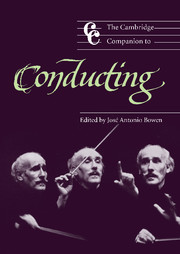1 - The technique of conducting
from Part I - Practice
Published online by Cambridge University Press: 28 September 2011
Summary
Any discussion of conducting technique can be problematic. The potential for disagreement over what constitutes a conductor's technique is huge, so this chapter will be limited to the ways in which conductors express their thoughts and ideas through physical movements, the tools they use, and the skills that they employ. The film footage of conductors like Willem Mengelberg, Wilhelm Furtwängler, Klaus Tennstedt, and Pierre Boulez demonstrates that there are as many styles of conducting as there are conductors, and to attempt to codify, to dissect, and to analyze fully the variety of gestures used by conductors is beyond the scope of this, or perhaps any, chapter. Although the gesticulations that they use seem to vary widely, all conductors' techniques have a basic task in common: to act as a kind of conduit through which their ideas are transmitted to the musicians. Of course, body movements are not all they use: a conductor also communicates verbally in rehearsal and makes eye contact with fellow performers throughout the performance process. A member of the Sydney Symphony Orchestra once remarked laconically to the present author that “it matters not whether a conductor stands on his head and wiggles his toes or beats time like a metronome as long as his intentions are clear.” While the first position described has more in common with yoga than music, the player's basic thesis has merit; clarity of intention is paramount for any conductor.
- Type
- Chapter
- Information
- The Cambridge Companion to Conducting , pp. 1 - 16Publisher: Cambridge University PressPrint publication year: 2003
- 3
- Cited by



